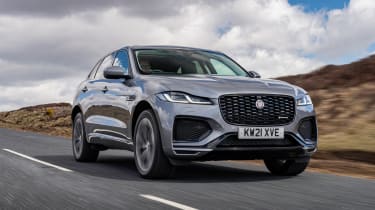Jaguar F-Pace (2016 - 2024) – MPG and running costs
Comparable to its rivals in terms of economy, that’s to say respectable for an SUV but far from exceptional
Gone are the days when SUVs of any size were able to verge on 60mpg (on paper) like the original F-Pace did due to the old NEDC cycle, which means that despite having appreciable gains in efficiency over the years, the numbers might not immediately show it. Still, D200 four-cylinder diesel is just about on a par for the class, with a 43.5mpg rating. This drops to 38.3mpg for the bigger six-cylinder D300. Petrol P250s are hit by their lack of any mild-hybrid assistance, hitting 30.3mpg, but the P400 somewhat makes up for it by only being a couple of mpg worse off at 28.9mpg.
Plug-in hybrid P400e models hit a claimed 172mpg, but as with all plug-ins the test cycle takes into account a full battery charge, which explains the sky-high figures. In the real world, if your daily commute is less than 31(ish) miles and you have a plug to charge it at every location it can be a very inexpensive way of getting around (high electricity prices notwithstanding). The plug-in also makes a case for itself as a company car, with much lower benefit in kind and company car tax to pay on account of its low CO2 figures.
The opposite might be said for the SVR, which has a rating of 23.5mpg – not bad, you might agree, for a near 2.1-ton SUV with a supercharged V8 engine, but enjoy that V8 and those numbers will rarely get close to 20mpg.
Another big expenditure will be tyres, especially if you order the optional 22-inch wheels. They might look great, but replacement 265/40/R22 Pirelli P Zeros cost approximately £300. Each. But broadly, the F-Pace has been a model of reliability over its lifetime, with powertrains and hardware generally remaining perfectly resilient, and even the electronics holding up well.




